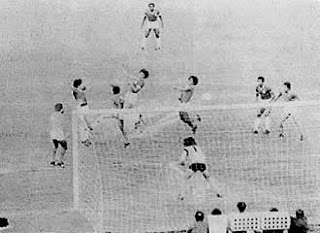The Intercontinental Cup was not played at all in 1975. It was logical fiasco – the European interest was declining for years and after the mediocre performance of the South Americans in the 1974 World Cup, there was no attraction left. It was expensive show, promising no financial returns on one hand, and high risk of heavy injuries of players, on the other. Runner-ups represented Europe in the last few years, the champions refusing to participate. If anything, the absence of the yearly challenge further diminished the European interest in South American football as far as seeing it was concerned. But in the same time more and more South American players were coming to play in Europe. Since European season is generally spread into two years, transfers made in 1974 will be mentioned here: high profile Brazilians were coming. Atletico Madrid bought Luis Pereira and Leivinha from the 1974 World Cup Brazilian selection. This transfer was both normal and not: Spain was the obvious destination of big stars, but Atletico already had 2 foreign players and under Spanish rules was prohibited to play more in a single match. Yet, Luis Pereira, Leivinha, and Argentines Heredia and Ayala played for a lot for Atletico. But the more interesting transfer was French: Olympique Marseille acquired Jairzinho and Paulo Cesar Lima – Caju. It was a transfer of real mega-stars, pointing at the market changes: European clubs were paying much more and South American countries had no way to prevent their stars from following the cash. Back in the 1960s it was different: Pele, for instance, was declared ‘national treasure’ by the Brazilian government and thus nobody outside the country was able to buy him. No more restrictions now, except temporary ones, when world cup was near. That was one side of the transfer – the other was the destination. French clubs, having rather small budgets, generally did not buy major stars, so this transfer signified a new direction. Yet, the buyer was Marseille – this club from time to time had ambitious ideas of becoming really superclub, meaning extravagant spending, and usually without results. The coming of Jairzinho and Paulo Cesar Lima turned out to be disaster – the players were aging, underperformed, and were not particularly happy in France. Marseille failed to win the championship and also failed to become one of the European superclubs. 
Top, left to right: Tresor, Victor Zvunka, Vanucci, Bracci, Charrier, Bulgues.
Bottom: Emon, Jairzinho, Albaladejo, Bereta, Paulo Cesar Lima.
By the names, should have been mighty team, with particularly lethal attack. It was not… and in the summer of 1975 the Brazilians returned home. Marseilles’ accounting department was relieved and nobody missed the legends.

Top, left to right: Tresor, Victor Zvunka, Vanucci, Bracci, Charrier, Bulgues.
Bottom: Emon, Jairzinho, Albaladejo, Bereta, Paulo Cesar Lima.
By the names, should have been mighty team, with particularly lethal attack. It was not… and in the summer of 1975 the Brazilians returned home. Marseilles’ accounting department was relieved and nobody missed the legends.
 With the Brazilian championship cup, the best South American statistically: he was the only player by 1975 voted best on the continent twice.
With the Brazilian championship cup, the best South American statistically: he was the only player by 1975 voted best on the continent twice. 





















